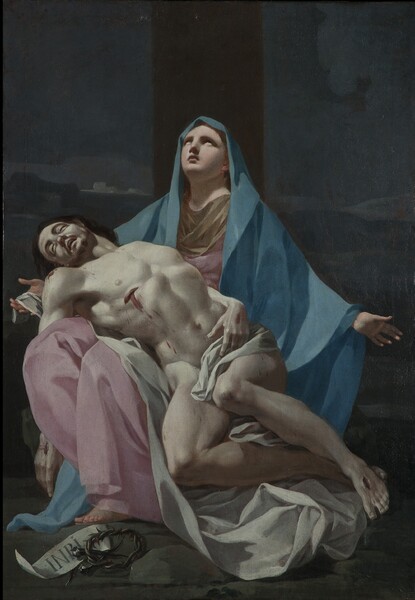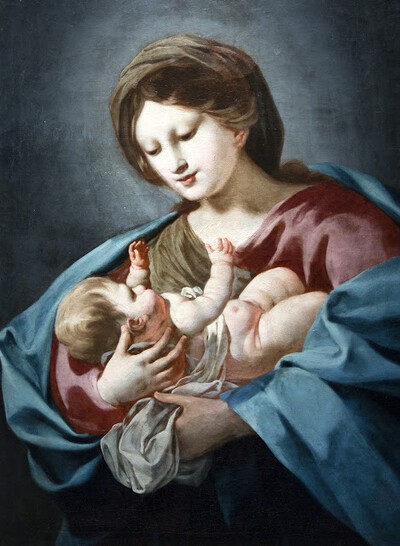- Cronología
- Ca. 1772 - 1773
- Ubicación
- Museum of Romanticism, Madrid, Spain
- Dimensiones
- 83,5 x 58 cm
- Técnica y soporte
- Oil on canvas
- Reconocimiento de la autoría de Goya
- Attributed work
- Titular
- Museum of Romanticism
- Ficha: realización/revisión
- 24 Aug 2022 / 12 Dec 2023
- Inventario
- (CE0021)
In the mid 19th century this work was owned by a canon of the Cesaraugustan Cabildo. It remained in a collection in Zaragoza until its acquisition by a private collector of Barcelona in 2008. It was auctioned at the Abalarte auction room in Madrid on November 30, 2022, with a starting price of 3 million euros, without obtaining a buyer.
It is possible that in the past it formed a pair with the Virgin and Child of almost identical size.
The composition focuses on the two figures in front, The Virgin and the dead Christ on her lap. Behind, the cross, of which only the upper part is visible. At the bottom of the figures we find symbols of the Passion: the cartouche with the acronym INRI, the crown of thorns and the nails of the crucifixion. The anatomical disposition of Christ, somewhat artificial, as well as the attitude of the Virgin, are reminiscent of Michelangelo´s Pietà, a work that Goya may have known directly in Rome. Mary´s gesture, stretching out her arms and looking upwards with contained emotion, is reminiscent of Agostino Carraci's Pietà (1579), which he may have known through prints.
On a background of semi-darkness, the figures are highlighted by a powerful spotlight of white light, outside the painting, which emphasizes their monumentality at the same time as it heightens the pastel shades of blue, pink and ochre of the clothing. The dramatism expressed by the Virgin's face, similar in form and disposition to that of The Daughter of Jephthah, as well as the pathetic lacerations of Christ's body, are subordinated to a sense of academic elegance and chromatism of rococo taste that, from a stylistic point of view, bring this painting closer to some scenes of the Charterhouse of Aula Dei or to the figure of Mary in The Triple Generation.
X-radiography of the painting revealed a completely different underlying composition, a full-length male figure covered with a cloak reminiscent of the "Sanjoaquins" in The Triple Generation or in Aula Dei. The reuse of canvases was common in Goya's work.
It is in a good conservation condition, it keeps the original hemp canvas and the original stretcher.
-
Goya y Zaragoza (1746-1775). Sus raíces aragonesasMuseo Goya. Colección IbercajaZaragoza2015cat. 19
-
Madrid2011pp. 52-66
-
Goya y Zaragoza (1746-1775). Sus raíces aragonesasZaragozaFundación Goya en Aragón, Ibercaja y Gobierno de Aragón2015pp. 144-145

